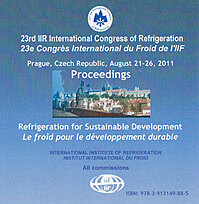
Summary
A heat pump dedicated to building heating (e.g., of the air-to-water type) is subject to variations in the cold source temperature, in the load demand or even in capacity when performance is aimed at. Such changes influence the internal behaviour of the heat pump and a ad hoc control can be achieved provided that a dynamic model describing the mass and heat balances is used.
The authors introduce a dynamic, lumped-parameter model based on moving-boundary exchanger sub-models, static compressor and expansion valve sub-models. The interests of the model for heat pump sizing or for the design of thesuperheating control are shown. Moreover, a refined version of the model is presented here as the desuperheating region of the condenser is described separately, instead of being merged into the condensation region. The benefits of this enhancement are evaluated with respect to the superheating control. Validation through experience will take place in a future but high-priority development step.
Available documents
Format PDF
Pages: 8 p.
Available
Public price
20 €
Member price*
Free
* Best rate depending on membership category (see the detailed benefits of individual and corporate memberships).
Details
- Original title: Evaluation of the benefits in heat pump design when using a dynamic lumped-parameter model.
- Record ID : 30001983
- Languages: English
- Source: Proceedings of the 23rd IIR International Congress of Refrigeration: Prague, Czech Republic, August 21-26, 2011. Overarching theme: Refrigeration for Sustainable Development.
- Publication date: 2011/08/21
Links
See other articles from the proceedings (569)
See the conference proceedings
Indexing
-
Themes:
Heat pumps techniques;
Energy efficiency, energy savings - Keywords: Design; Control (automatic); Superheat; Heat pump; Modelling
-
Laboratory characterization of a cascade heat p...
- Author(s) : MENEGON D., CAMPIDELLI M., FEDRIZZI R.
- Date : 2023/05
- Languages : English
- Source: 14th IEA Heat Pump Conference 2023, Chicago, Illinois.
- Formats : PDF
View record
-
Model based control development for heat pump w...
- Author(s) : LI Z., ZHU Y., JIN Y., YUAN Y., MA C., YANG X.
- Date : 2024/07/17
- Languages : English
- Source: 2024 Purdue Conferences. 20th International Refrigeration and Air-Conditioning Conference at Purdue.
- Formats : PDF
View record
-
Load-Based Testing Methodology for Evaluating A...
- Author(s) : DHILLON P., HORTON W. T., BRAUN J. E.
- Date : 2021/08/31
- Languages : English
- Source: 13th IEA Heat Pump Conference 2021: Heat Pumps – Mission for the Green World. Conference proceedings [full papers]
- Formats : PDF
View record
-
An air-water dual-source heat pump system for s...
- Author(s) : CHENG J. H., GAO P., CAO X., SHAO P., SHAO L. L., ZHANG C. L.
- Date : 2021/08/31
- Languages : English
- Source: 13th IEA Heat Pump Conference 2021: Heat Pumps – Mission for the Green World. Conference proceedings [full papers]
- Formats : PDF
View record
-
Tailoring the heat pump system controller to th...
- Author(s) : WILL F., KLINGEBIEL J., VERING C., MÜLLER D.
- Date : 2024/07/15
- Languages : English
- Source: 2024 Purdue Conferences. 8th International High Performance Buildings Conference at Purdue.
- Formats : PDF
View record
